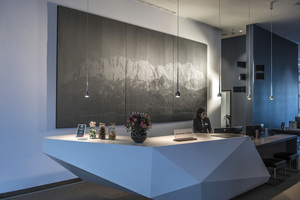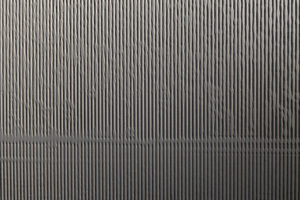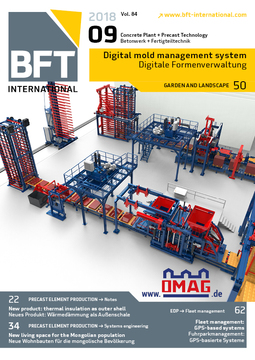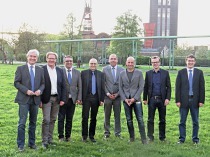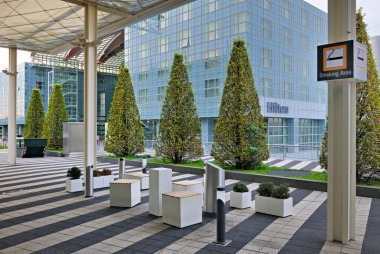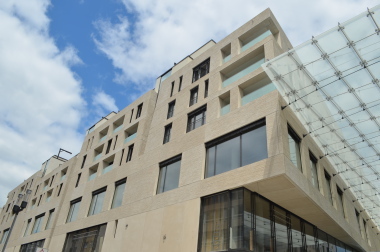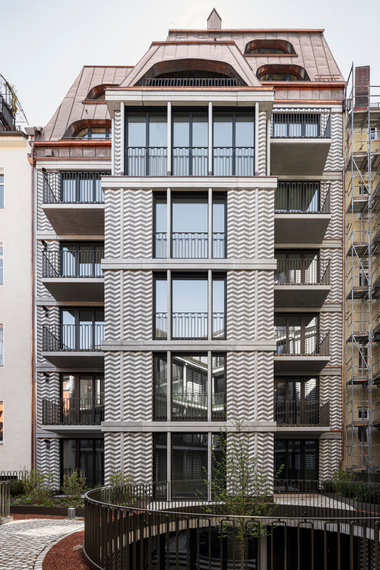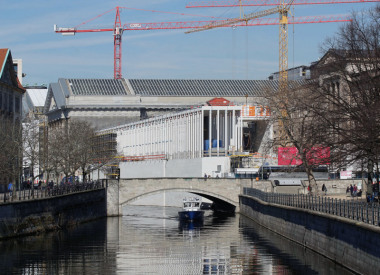Zugspitze wall relief made of architectural concrete
At Munich airport, the capacity of the Hilton Munich Airport Hotel was expanded more than threefold following comprehensive conversion and enlargement. People who attend conferences there will in most cases have no time for sightseeing. But the architect Claudia Schmitt-Rider of Gumpp Heigl Schmitt Architects in Munich did not want to deprive conference attendees of the special attraction of the surrounding environment – and she also wanted to give the new rooms an individual and original look. She continued the new design concept of the converted hotel with a blue-white color scheme, wooden floors and exposed concrete up to the conference area, and established a reference to the Bavarian landscape beginning in the reception area. A nature relief of a very special kind now hangs above the impressive reception counter. The image, with its smooth white surface, resembles an alpine glacial tongue and has an extraordinary effect. The concrete wall relief, 2.5 x 6.0 m in size, shows in exactingly formed relief the Wetterstein Mountains with the Zugspitze peak as viewed from Alpsee Lake in the Ostallgäu district.
The typical landscape motif, which in its traditional version adorns many a living room, now stylized in the hotel in relief, produces an unexpected impression. The varying heights of the concrete relief, depending on the angle of light incidence and viewing direction, create an ever-changing, unexpected and surprisingly changing image. This wall sculpture expresses both modernity and association with the location – and reference to the scenery that avoids evoking a feeling of familiarity. The familiar motif, which everyone knows, employs variation in aspects to create completely novel perception. This can – going far beyond the theme – lead to development of new insights, of the kind that only art, with its amazing expressive power, is often able to grasp, often far beyond human intelligence.
Art made of concrete
Based on a photo motif, the architect Schmitt-Rider, in collaboration with the precast plant Betonfertigteilwerk Bachl and with Reckli, the manufacturer of formliners, succeeded in a stylized implementation of a massive wall relief. For this purpose, several elements were manufactured with individually produced formliners that during casting formed relief steps of various heights; sampling was directly at the final installation site. Based on light incidence at the site, a decision was possible on the final most suitable shape of the heights and depths. “We manufactured the art object, which weighs 5 tons, in three parts to facilitate transport and flexibility at the installation site,” as Wolfgang Paul, Division Manager at the precast plant Betonwerke Bachl, described the process of production. For the one-off creation, the architect wanted to have the natural cement-gray look of concrete. “We manufactured the elements in architectural concrete quality with CEM 52,5 R from the HeidelbergCement plant at Burglengenfeld,” says Paul. Bachl, who manufactures at all sites with various cements from HeidelbergCement AG, has extensive experience with textured concrete surfaces and with architectural concrete as used on many façades.
For the hotel installation, a carrier specialized in art transports used a roller-mounted spider crane to install the heavy wall element. The three concrete elements were flush-mounted with 5-mm joints in the surrounding wall and invisibly fixed to a steel construction. “Both client and architect were very satisfied,” recalls the Division Manager, for whom production of the artistic wall sculpture of course had a different significance than casting of concrete slabs. “We calculated at cost,” he said. We can thank the architect for the artistic expression of the mountain massif. The fascinating effect of the work of art is something that everyone can preserve for themselves, quite conventionally in their mind, or – in keeping with the zeitgeist – digitally or on a smartphone.

